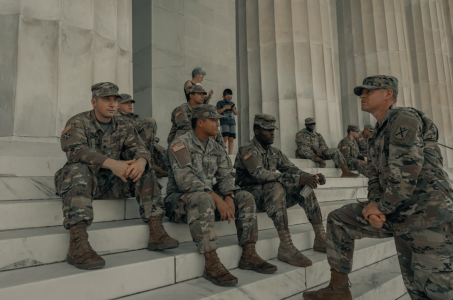Soldiers’ appearance standards are changing under a new US Army policy
- Replies 0
Appearance often carries more weight than people realize, especially in organizations built on tradition and structure.
Small details, from the way a uniform sits to the way a haircut is maintained, can send signals about discipline and cohesion.
When standards shift, it reflects not only a change in policy but also the values an institution wants to project. And for one of the country’s most visible organizations, those updates are now taking shape.
The US Army has issued a new directive that changes how soldiers are expected to present themselves in uniform.
The policy, which will take effect within 30 days of publication, applies across the Regular Army, Army National Guard, and US Army Reserve.
Officials describe the move as a way to reinforce uniformity and professionalism while clarifying existing rules.
“What sets the US Army apart is our professionalism, and that’s a direct reflection of committed Soldiers who adhere to and enforce the standards,” said Sargent Major of the Army, Michael Weimer.

Among the updates are stricter guidelines for hair, cosmetics, jewelry, and uniforms, all meant to create a more consistent and polished appearance.
Men will not be permitted to wear braids, twists, locs, or cornrows, nor will they be able to cut designs into their hair.
Male soldiers are also barred from wearing earrings, nail polish, or any cosmetics. Women, meanwhile, may continue to wear makeup and nail polish, but it must be conservative, with limits on items such as false eyelashes, tattooed makeup, and bright lipstick.
The policy also clarifies that female soldiers may wear braids, twists, locs, or cornrows, though they must follow specific rules to ensure a neat and professional appearance. Earrings remain limited to simple studs, and nail polish must be clear.
Also read: Tighter US border controls spur shift to riskier crossings
For men and women alike, the directive touches on body composition standards, insignia placement, and other uniform requirements.
Together, the changes mark an effort to keep presentation consistent across the ranks while still accommodating some personal expression within defined boundaries.
This shift in grooming and appearance standards comes at a time when the Army is also reshaping its approach to fitness.
Earlier this year, leaders announced the replacement of the Army Combat Fitness Test with the new Army Fitness Test, which includes five events designed to better measure strength and readiness.
Also read: Discover 50 bizarre bans you’d never expect in the US
The new scoring system will begin rolling out in 2026, with separate timelines for active-duty and reserve components.
Both moves suggest an ongoing focus on aligning the Army’s image and capabilities with modern expectations.
Read next: How the US Postal Service has kept America connected—by train, plane, and even dog sled

Do you believe these grooming updates strike the right balance between professionalism and personal freedom, or should the Army allow more flexibility? Share your thoughts in the comments and join the discussion on where tradition and change should meet in today’s military.
Small details, from the way a uniform sits to the way a haircut is maintained, can send signals about discipline and cohesion.
When standards shift, it reflects not only a change in policy but also the values an institution wants to project. And for one of the country’s most visible organizations, those updates are now taking shape.
The US Army has issued a new directive that changes how soldiers are expected to present themselves in uniform.
The policy, which will take effect within 30 days of publication, applies across the Regular Army, Army National Guard, and US Army Reserve.
Officials describe the move as a way to reinforce uniformity and professionalism while clarifying existing rules.
“What sets the US Army apart is our professionalism, and that’s a direct reflection of committed Soldiers who adhere to and enforce the standards,” said Sargent Major of the Army, Michael Weimer.

Soldiers’ appearance standards are changing under a new US Army policy. Image source: Clay Banks / Unsplash
Among the updates are stricter guidelines for hair, cosmetics, jewelry, and uniforms, all meant to create a more consistent and polished appearance.
Men will not be permitted to wear braids, twists, locs, or cornrows, nor will they be able to cut designs into their hair.
Male soldiers are also barred from wearing earrings, nail polish, or any cosmetics. Women, meanwhile, may continue to wear makeup and nail polish, but it must be conservative, with limits on items such as false eyelashes, tattooed makeup, and bright lipstick.
The policy also clarifies that female soldiers may wear braids, twists, locs, or cornrows, though they must follow specific rules to ensure a neat and professional appearance. Earrings remain limited to simple studs, and nail polish must be clear.
Also read: Tighter US border controls spur shift to riskier crossings
For men and women alike, the directive touches on body composition standards, insignia placement, and other uniform requirements.
Together, the changes mark an effort to keep presentation consistent across the ranks while still accommodating some personal expression within defined boundaries.
This shift in grooming and appearance standards comes at a time when the Army is also reshaping its approach to fitness.
Earlier this year, leaders announced the replacement of the Army Combat Fitness Test with the new Army Fitness Test, which includes five events designed to better measure strength and readiness.
Also read: Discover 50 bizarre bans you’d never expect in the US
The new scoring system will begin rolling out in 2026, with separate timelines for active-duty and reserve components.
Both moves suggest an ongoing focus on aligning the Army’s image and capabilities with modern expectations.
Read next: How the US Postal Service has kept America connected—by train, plane, and even dog sled
Key Takeaways
- The Army has announced new grooming and appearance standards that apply to men and women across all branches of service.
- The directive bans certain hairstyles, cosmetics, and jewelry for male soldiers, while setting limits on makeup and accessories for women.
- The changes take effect within 30 days and are meant to reinforce consistency, discipline, and professionalism across the ranks.
- Alongside grooming updates, the Army is also introducing a new fitness test to better reflect modern readiness requirements.






